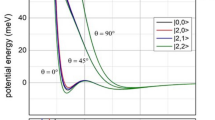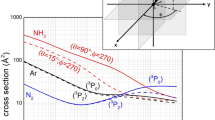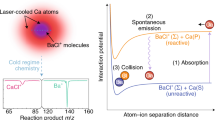Abstract
Chemical reaction dynamics are studied to monitor and understand the concerted motion of several atoms while they rearrange from reactants to products. When the number of atoms involved increases, the number of pathways, transition states and product channels also increases and rapidly presents a challenge to experiment and theory. Here we disentangle the dynamics of the competition between bimolecular nucleophilic substitution (SN2) and base-induced elimination (E2) in the polyatomic reaction F− + CH3CH2Cl. We find quantitative agreement for the energy- and angle-differential reactive scattering cross-sections between ion-imaging experiments and quasi-classical trajectory simulations on a 21-dimensional potential energy hypersurface. The anti-E2 pathway is most important, but the SN2 pathway becomes more relevant as the collision energy is increased. In both cases the reaction is dominated by direct dynamics. Our study presents atomic-level dynamics of a major benchmark reaction in physical organic chemistry, thereby pushing the number of atoms for detailed reaction dynamics studies to a size that allows applications in many areas of complex chemical networks and environments.

This is a preview of subscription content, access via your institution
Access options
Access Nature and 54 other Nature Portfolio journals
Get Nature+, our best-value online-access subscription
$29.99 / 30 days
cancel any time
Subscribe to this journal
Receive 12 print issues and online access
$259.00 per year
only $21.58 per issue
Buy this article
- Purchase on Springer Link
- Instant access to full article PDF
Prices may be subject to local taxes which are calculated during checkout




Similar content being viewed by others
Data availability
Data are provided in the online material accompanying this article. Source data are provided with this paper.
References
Xie, Y. et al. Quantum interference in H + HD → H2 + D between direct abstraction and roaming insertion pathways. Science 368, 767–771 (2020).
Zhang, X., Li, L., Chen, J., Liu, S. & Zhang, D. H. Feshbach resonances in the F + H2O → HF + OH reaction. Nat. Commun. 11, 223 (2020).
Yang, T. et al. Enhanced reactivity of fluorine with para-hydrogen in cold interstellar clouds by resonance-induced quantum tunnelling. Nat. Chem. 11, 744–749 (2019).
Pan, H., Liu, K., Caracciolo, A. & Casavecchia, P. Crossed beam polyatomic reaction dynamics: recent advances and new insights. Chem. Soc. Rev. 46, 7517–7547 (2017).
Liu, K. Vibrational control of bimolecular reactions with methane by mode, bond, and stereo selectivity. Annu. Rev. Phys. Chem. 67, 91–111 (2016).
Brouard, M., Parker, D. H. & van de Meerakker, S. Y. T. Taming molecular collisions using electric and magnetic fields. Chem. Soc. Rev. 43, 7279–7294 (2014).
Zhao, Z. Q., Zhang, Z. J., Liu, S. & Zhang, D. H. Dynamical barrier and isotope effects in the simplest substitution reaction via Walden inversion mechanism. Nat. Commun. 8, 14506 (2017).
Estillore, A. D., Visger, L. M. & Suits, A. G. Imaging the dynamics of chlorine atom reactions with alkenes. J. Chem. Phys. 133, 074306 (2010).
Herman, Z. & Futrell, J. H. Dynamics of ion-molecule reactions from beam experiments: A historical survey. Int. J. Mass Spectrom. 377, 84–92 (2015).
Wang, Y. et al. Mode-specific SN2 reaction dynamics. J. Phys. Chem. Lett. 7, 3322–3327 (2016).
Carrascosa, E., Meyer, J. & Wester, R. Imaging the dynamics of ion–molecule reactions. Chem. Soc. Rev. 46, 7498–7516 (2017).
Xie, J. & Hase, W. L. Rethinking the SN2 reaction. Science 352, 32–33 (2016).
Gronert, S. Gas phase studies of the competition between substitution and elimination reactions. Acc. Chem. Res. 36, 848–857 (2003).
Villano, S. M., Kato, S. & Bierbaum, V. M. Deuterium kinetic isotope effects in gas-phase SN2 and E2 reactions: A comparison of experiment and theory. J. Am. Chem. Soc. 128, 736–737 (2006).
Tajti, V. & Czakó, G. Benchmark ab initio characterization of the complex potential energy surface of the F− + CH3CH2Cl reaction. J. Phys. Chem. A 121, 2847–2854 (2017).
Yang, L. et al. Competing E2 and SN2 mechanisms for the F− + CH3CH2I reaction. J. Phys. Chem. A 121, 1078–1085 (2017).
Carrascosa, E. et al. Imaging dynamic fingerprints of competing E2 and SN2 reactions. Nat. Commun. 8, 25 (2017).
Hamlin, T. A., Swart, M. & Bickelhaupt, F. M. Nucleophilic substitution (SN2): Dependence on nucleophile, leaving group, central atom, substituents, and solvent. ChemPhysChem 19, 1315–1330 (2018).
Eyet, N., Melko, J. J., Ard, S. G. & Viggiano, A. A. Effect of higher order solvation and temperature on SN2 and E2 reactivity. Int. J. Mass Spectrom. 378, 54–58 (2015).
Hase, W. L. Simulations of gas-phase chemical reactions: applications to SN2 nucleophilic substitution. Science 266, 998–1002 (1994).
Viggiano, A. A., Morris, R. A., Paschkewitz, J. S. & Paulson, J. F. Kinetics of the gas-phase reactions of chloride anion, Cl− with CH3Br and CD3Br: experimental evidence for nonstatistical behavior? J. Am. Chem. Soc. 114, 10477–10482 (1992).
Sun, L., Song, K. & Hase, W. L. A SN2 reaction that avoids its deep potential energy minimum. Science 296, 875–878 (2002).
Czakó, G. et al. Benchmark ab initio and dynamical characterization of the stationary points of reactive atom + alkane and SN2 potential energy surfaces. Phys. Chem. Chem. Phys. 22, 4298–4312 (2020).
Xie, J. et al. Identification of atomic-level mechanisms for gas-phase X− + CH3Y SN2 reactions by combined experiments and simulations. Acc. Chem. Res. 47, 2960–2969 (2014).
Meyer, J. et al. Unexpected indirect dynamics in base-induced elimination. J. Am. Chem. Soc. 141, 20300–20308 (2019).
Liu, X., Zhang, J., Yang, L. & Hase, W. L. How a solvent molecule affects competing elimination and substitution dynamics. Insight into mechanism evolution with increased solvation. J. Am. Chem. Soc. 140, 10995–11005 (2018).
Mugnai, M., Cardini, G. & Schettino, V. Substitution and elimination reaction of F− with C2H5Cl: An ab initio molecular dynamics study. J. Phys. Chem. A 107, 2540–2547 (2003).
Stei, M. et al. Influence of the leaving group on the dynamics of a gas-phase SN2 reaction. Nat. Chem. 8, 151–156 (2016).
Mikosch, J. et al. Imaging nucleophilic substitution dynamics. Science 319, 183–186 (2008).
Carrascosa, E., Meyer, J., Michaelsen, T., Stei, M. & Wester, R. Conservation of direct dynamics in sterically hindered SN2/E2 reactions. Chem. Sci. 9, 693–701 (2018).
Zhang, J., Xie, J. & Hase, W. L. Dynamics of the F− + CH3I → HF + CH2I− proton transfer reaction. J. Phys. Chem. A 119, 12517–12525 (2015).
Walden, P. Über die gegenseitige Umwandlung optischer Antipoden. Ber. Dtsch. Chem. Ges. 29, 133–138 (1896).
Eppink, A. T. J. B. & Parker, D. H. Velocity map imaging of ions and electrons using electrostatic lenses: Application in photoelectron and photofragment ion imaging of molecular oxygen. Rev. Sci. Instrum. 68, 3477–3484 (1997).
Wester, R. Velocity map imaging of ion–molecule reactions. Phys. Chem. Chem. Phys. 16, 396–405 (2014).
Bastian, B. et al. Imaging reaction dynamics of F−(H2O) and Cl−(H2O) with CH3I. J. Phys. Chem. A 124, 1929–1939 (2020).
Fateley, W. G. & Miller, F. A. Torsional frequencies in the far infrared - III: The form of the potential curve for hindered internal rotation of a methyl group. Spectrochim. Acta 19, 611–628 (1963).
Győri, T. & Czakó, G. Automating the development of high-dimensional reactive potential energy surfaces with the ROBOSURFER program system. J. Chem. Theory Comput. 16, 51–66 (2020).
Xie, Z. & Bowman, J. M. Permutationally invariant polynomial basis for molecular energy surface fitting via monomial symmetrization. J. Chem. Theory Comput. 6, 26–34 (2010).
Werner, H.-J. et al. Molpro, v.2015.1 (Molpro, 2015); http://www.molpro.net
Hase, W. L. in Encyclopedia of Computational Chemistry Vol. 1 (ed. Allinger, N. L.) 399–407 (Wiley, 1998).
Acknowledgements
R.W. thanks the Austrian Science Fund (FWF), project P25956-N20, for support of this work. G.C. thanks the National Research, Development and Innovation Office-NKFIH, K-125317, the Ministry of Human Capacities, Hungary grant 20391-3/2018/FEKUSTRAT and the Momentum (Lendület) Program of the Hungarian Academy of Sciences for financial support. We acknowledge KIFÜ for awarding us access to computational resources based at Debrecen in Hungary. J.M. acknowledges support from a Hertha Firnberg Fellowship of the Austrian Science Fund (T962-N34). E.C. acknowledges support from the DOC Fellowship of the Austrian Academy of Science.
Author information
Authors and Affiliations
Contributions
E.C., J.M. and M.S. carried out the experiment. J.M. and E.C. analysed the data. B.B. extended the data analysis program suite. T.M. and B.B. contributed to data discussion and interpretation. V.T. and T.G. developed the potential energy surface. V.T. performed the trajectory simulations and analysed the data. G.C. and R.W. supervised the project. J.M. and R.W. prepared the manuscript. V.T. and G.C. contributed the theoretical sections.
Corresponding authors
Ethics declarations
Competing interests
The authors declare no competing interests.
Additional information
Peer review information Nature Chemistry thanks Piergiorgio Casavecchia, Dunyou Wang and Xingan Wang for their contribution to the peer review of this work.
Publisher’s note Springer Nature remains neutral with regard to jurisdictional claims in published maps and institutional affiliations.
Supplementary information
Supplementary Information
Supplementary Materials and Methods, Figs. 1–10.
Supplementary Data 1
Source data to support the plots in the Supplementary Information file.
Supplementary Data 2
Initial and final QCT coordinates, 0.35 eV.
Supplementary Data 3
Initial and final QCT coordinates, 0.83 eV.
Supplementary Data 4
Initial and final QCT coordinates, 1.15 eV.
Supplementary Data 5
Initial and final QCT coordinates, 1.6 eV.
Supplementary Data 6
Initial and final QCT coordinates, 1.98 eV.
Source data
Source Data Fig. 2
Source data for Fig. 2.
Source Data Fig. 3
Source data for Fig. 3.
Source Data Fig. 4
Source data for Fig. 4.
Rights and permissions
About this article
Cite this article
Meyer, J., Tajti, V., Carrascosa, E. et al. Atomistic dynamics of elimination and nucleophilic substitution disentangled for the F− + CH3CH2Cl reaction. Nat. Chem. 13, 977–981 (2021). https://doi.org/10.1038/s41557-021-00753-8
Received:
Accepted:
Published:
Issue Date:
DOI: https://doi.org/10.1038/s41557-021-00753-8
This article is cited by
-
Unexpected steric hindrance failure in the gas phase F− + (CH3)3CI SN2 reaction
Nature Communications (2022)



